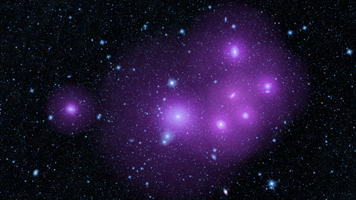
Unlabeled version
High resolution TIFF
Click on the image for larger versionActive, supermassive black holes at the hearts of galaxies tend to fall into two categories: those that are hidden by dust, and those that are exposed. Data from NASA's Wide-field Infrared Survey Explorer, or WISE, have shown that galaxies with hidden supermassive black holes tend to clump together in space more than the galaxies with exposed, or unobscured, black holes.
This enhanced image shows galaxies clumped together in the Fornax cluster, located 60 million light-years from Earth. The picture was taken by WISE, but has been artistically enhanced to illustrate the idea that clumped galaxies will, on average, be surrounded by larger halos of dark matter (represented in purple). Because dark matter, like normal matter, has gravity, it will pull galaxies toward it, causing them to clump.
Astronomers don't know why the hidden black holes would have larger halos of dark matter, but are intrigued by the surprising finding and are investigating further.
More information is online at http://www.nasa.gov/wise and http://wise.astro.ucla.edu and http://www.jpl.nasa.gov/wise.

